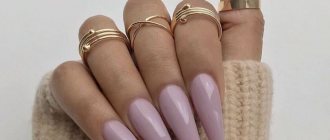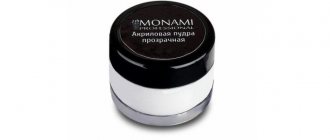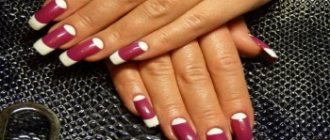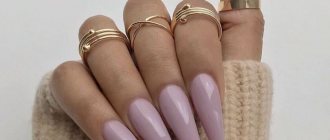Every girl wants to be irresistible. To make your look complete and stylish, even little things like nails can play an important role. Beautiful and well-groomed nails make a woman sexy and attractive. But, unfortunately, not everyone has been blessed with such beauty by nature.
How nail extensions are done - practicing nail artists, on the instructions of the COLADY editors, tell us step-by-step extension technology.
Pexels Photos
Nail extension is a simple procedure that will help make your hands neater and your image complete. Before deciding on the procedure, read interesting reviews and watch useful video tutorials about nail extensions.
Cons of nail extensions
- Quite a high cost of the nail extension procedure;
- When preparing the nail, it will be exposed to mechanical devices, damaging it;
- If you come across an unscrupulous master, deformation of the nail may occur;
- You may develop an allergy to the components that make up the extension materials;
- If the extended nail breaks, it breaks in the middle of the nail plate, which is very painful and does not lead to anything good.
- Extended nails require correction, so you will have to find time and money to visit the salon;
- Natural nails become thinner after removing extensions. You will have to spend a lot of effort to get your natural nails in order.
- Gel nails cannot be removed, they will have to be filed off. Only a master can perform such a procedure.
What is fiberglass?
Fiberglass (fiberglass) is a plastic material consisting of glass supplemented with chemical components. Used for extension, correction and strengthening of nails.
The material consists of glass fibers connected into a roll, tape or bundle. The individual fiber is very thin, but strong and flexible. You can find fiberglass of various lengths and thicknesses on sale. The thicker the material, the more durable it is, but less flexible.
Thicker fiberglass is suitable for nail extensions and corner extensions. It perfectly forms the free edge, creates additional volume and does not wrinkle when worn.
Thin fiberglass is more flexible, does not add volume, but remains just as durable. It is recommended for repairing extended nails, completing walls and reinforcing the architecture of the plate.
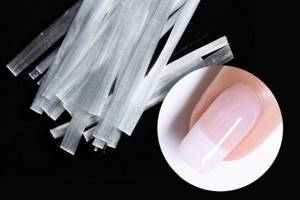
To work with various coatings and combine techniques, the master needs to stock up on both thin and thick fiberglass. If you count on the maximum extension length, one package of fiberglass is enough for about 40 nails.
Gel and acrylic nail extensions - comparison
At the moment, there are 2 main materials for nail extensions - acrylic and gel.
- Acrylic is a special powder that is mixed with a special liquid. The result is a thick and sticky substance that is applied to the nail. A professional can properly extend acrylic nails, since the acrylic mixture quickly hardens in air. But, with certain skills, acrylic nail extensions can be done at home. After applying the mixture to the nail, it is trimmed, polished and coated. Acrylic nails are very durable, but if you still manage to break them, a specialist in the salon can easily repair the damage. Acrylic nails are easy to remove : using a special product, acrylic is dissolved and removed. The only drawback of acrylic nails is the specific smell of the material, which will accompany you for some time. But then the smell will disappear.
- Gel is also a good material for nail extensions. Thanks to the gel, nails are not only strong, but also elastic. The gel allows the nails to breathe and allows moisture to pass through, which is good for the nails. Gel nails harden under the influence of ultraviolet rays, which will not allow fungus to develop on the nail plate in the future. To make the nail stronger, the procedure is repeated several times. When the last layer of gel has hardened, the nail can be given the desired shape and coated with varnish. Gel nails can be done in a salon by an experienced nail technician, but gel nail extensions can be easily done at home if you purchase everything you need for the procedure and study the instructions. The advantages of gel nails include durability (service life can reach up to 5 months). Among the disadvantages are the following: if a nail breaks, it cannot be restored ; you will have to make a new one. Getting rid of gel nails is also difficult. Frozen gel can only be removed by a master by filing .
To be honest, gel and acrylic belong to the same group of “acrylates”, so it’s impossible to say for sure which is better. Each person chooses the most optimal extension option and follows it. At the moment, there is a special technology that allows you to combine acrylic and gel: first acrylic is applied to the nail, which makes the nail stronger, then gel is applied to add shine.
What to combine fiberglass with?
Fiberglass can be safely combined with any nail plate design products. Porous fibers are well impregnated, and when polymerized they form a perfectly smooth fabric.
- Fiberglass + classic varnishes or weekly gel varnishes Usually these materials are combined when the plate needs to be strengthened or repaired before coating, to be sure that the nail will be safe and sound.
- Fiberglass + gel polish or shellac Gel polishes with fiberglass are used when nails are fragile and thin. Since both materials are durable and flexible, the manicure is durable but light.
- Fiberglass + biogel This combination is suitable for clients with health restrictions (allergies, bronchial asthma). Using biogel with fiberglass overlay, you can level the surface of the nail and strengthen it. As a result, you get more well-groomed, healthy nails, and their growth also improves.
Fiberglass in general allows you to reduce the costs of the master, but to work with it you need to purchase certain tools and accessories. However, if you have been interested in the field of nail art for a long time, most likely you already have much of the list of materials.
All methods of nail extension - with tips, with paper forms, with top forms, with liquid tips
There are several types of nail extensions. Each type is different from each other and has its own advantages and disadvantages.
Nail extension with tips
Illustration by Colady
Tips are plastic plates that are attached at one end to the nail before applying gel or acrylic. After applying the material, the extended nails are covered with varnish and a design is applied. The color and size of tips can be very diverse.
There are liquid tips (reusable forms with which an artificial nail is made. This method does not use disposable forms or tips).
An important advantage of liquid tips is the non-use of glue. Glue is the most toxic substance used for any nail extension. Using liquid tips you can:
- Create reusable forms, which significantly saves the budget;
- Create the perfect arched jacket;
- Create unique and complex designs;
- Possibility of creating a pedicure.
Properly selected tips can only use a small part of the nail, which protects your nails. After fixing the tips, the nails can be given any shape or length. Here everything depends only on the imagination and skill of the master.
Form nail extensions
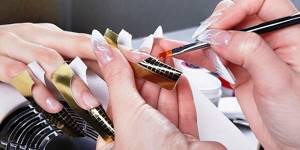
Forms are disposable paper bases, the outer side of which is coated with a special compound, and the inner side is coated with an adhesive component. Paper forms are thrown away after use. There are reusable forms made of metal. These forms are attached to the nail using a metal clip. For subsequent use, the metal mold must be disinfected.
Original nail design – fun new items for fall 2022
No major changes are planned. Designers are going to update existing images, work with the latest trends, mix new trends and transform them into unique designs.
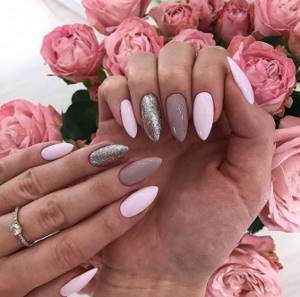
Autumn looks are characterized by simplicity and elegance. Vulgar sparkles and flashy rhinestones have faded into oblivion. A simple manicure attracts with its mystery.
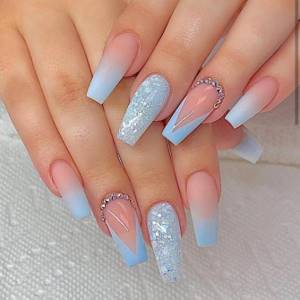
Geometric shapes remain relevant. Designers masterfully transform circles, squares, ovals, and triangles into unusual designs and create stylish abstractions from them.
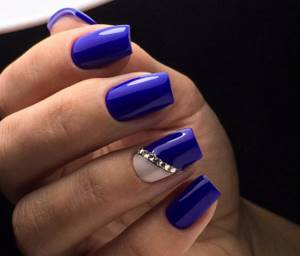
Traditionally, during the autumn months, fashionistas decorate their nails with seasonal motifs: yellowed leaves, tree branches, flowers and berries. The color scheme used to create a manicure is replete with yellow-orange shades.
How to care for extended nails
Many people believe that it is not necessary to take care of your nails after extensions. But that's not true! Any material does not last forever and requires special care, especially since natural nails tend to grow. There is no way to do this without correction of extended nails.
To make your nails look beautiful and not break, it is important to follow some rules:
- Neither gel nor acrylic nails tolerate acetone. Therefore, choose nail polish remover without acetone, use non-aggressive household chemicals;
- Do not use wire cutters or scissors. A polisher and file for extended nails will help you adjust the length of your nails;
- Do not hit your nails on a hard surface, do not drop heavy objects on them and be careful;
- Take care of your cuticles. To prevent hangnails from forming and to keep the cuticle moisturized, moisturize it with vegetable oils. If your cuticle grows too quickly, use a special product to slow down its growth;
- Before a manicure, do not take baths, use only softening oils. This will help prevent damage to your nails;
- If you dive into a cold pool after a hot bath, you can damage your nails;
- When painting your nail extensions with varnish, use only high-quality varnishes. Pay attention to the consistency and shelf life of the varnish;
- It is recommended to go for correction at least once every 3 weeks;
- Do not resort to hardware manicure services. It contributes to weakening and brittleness of nails;
- Don't try to fix a broken nail yourself;
- It is recommended to remove extended nails only in salons;
- Do not cover your extended nails with a thick layer of varnish.
These are the basic rules for caring for extended nails, following which you will preserve their beauty and durability.
Removing fiberglass
The method of removing the material depends on what the fiberglass is coated with.
- If this is a gel for extensions, we cut it and the fibers with a cutter.
- If your nails are covered with gel polish, choose a special remover for shellac, i.e. We resort to soaking.
- If soaking is not suitable for our gel polish, we choose the hardware method of removing the material.
Read more about removal methods in the article “How to remove gel polish at home?”
So, fiberglass is a convenient, economical and multifunctional material. It goes well with various gels and varnishes and lasts a long time. Anyone can learn to work with fiberglass; you just need skill and a little practice. And, if you want to master this and other extension techniques to perfection, to become a real pro in the nail industry, we are waiting for you at manicure courses at ParisNail school!
Dense recording to the master
Make an appointment with a good master several months in advance. If you suddenly want to redo your manicure, you will have to run around looking for another specialist, and it is not a fact that he will be good. This state of affairs makes many women nervous, because the manicure does not deteriorate strictly according to the clock.

@nglnails2018
In fact, gel polish is much more fragile than it seems
If, on the 2-3rd day of wearing a fresh manicure, you inadvertently touch the coating with a knife while cooking, all hell breaks loose. The nail will show off an unaesthetic crack, scratch or chip. You won’t be able to redo it yourself, so you need to accept it or go to a specialist for just one nail. And this is again a waste of time.

@sofronova_nail
Naturalness is a new trend
Minimalism, simplicity and conciseness are the main trends of recent times. Today, you won’t find elaborate decor in the clothes of top fashion designers, and the cut of their clothes is becoming simpler every year. Modern makeup is the one that looks natural. And the most stylish modern colors are represented by natural shades: light brown, red and warm blonde.

@dolcegabbana
The trend towards minimalism and the nail industry has not escaped. In 2022, fewer and fewer fashion designers prefer gel polish: at the latest shows of Versace, Saint Laurent and Louis Vuitton, models walked the catwalk with completely bare nails.
And even stars choose manicures without coating. So, at one of the photo shoots for the jewelry brand FRED jewelry, actress Emma Roberts posed with her nails unpainted. And Russian supermodel Natalia Vodianova always goes without color on her nails. However, many famous models do this in order to look harmonious in any image.
Read also: What to wear when it’s very hot: 10 fashionable things for the summer

@louisvuitton
Gel polish is a series of strict rules and obligations that have tired many modern women. Let's find out why.
Gel extension technology on fiberglass
Fiberglass is the coolest know-how in the nail art space; it helps you create an incredible number of shapes and types, as well as add the length of your nails at your discretion.

Well, let's start studying the technology of gel nail extensions:
- Before starting work, wash your hands well, especially the nail plate area, to remove all possible contamination.
- Next, you should take care to create the necessary conditions for nail extensions. Namely, clear the work table of unnecessary things, prepare all materials and tools so that they are always at hand.
- We go over the edge of the cuticle with any cuticle remover.
- After 2-3 minutes, use an orange stick to lift it and carefully move the cuticle away from the nail edge. After this, the excess cuticle is removed with special knives or nippers.
- When the cuticle is removed, we recommend treating the skin above the nail on all fingers with a rich cream. We do this in order to protect the nails, since from oily skin it is easy to remove gel or other substances that accidentally got on the skin.
- Treat the plate with a primer, then apply an even base layer, send the nail to ultraviolet drying with an LED lamp, hold for 1-1.5 minutes.
- Then apply a second coat of base; now there is no need to dry.
- Next, we prepare the fiberglass: cut strips of the required length, lay them out carefully using tweezers and a stick. Make sure that there is a distance of 0.5-1 mm from the skin side ridges and top. After this, the polymerization stage occurs again.
- Next, gently squeeze the nail from the sides to get the desired shape.
- Now all that remains is to remove excess material using files and buffs, treat the nail with a degreaser, and then apply a top coat.
Next, you can look at photos of nail extensions, which depict the main stages of the procedure.
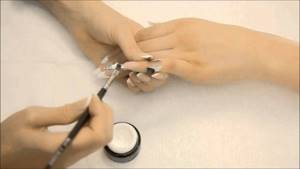
Precautionary measures
If you want long nails to last for a long time, it is important to use high-quality material, preferably from a manufacturer that has proven itself well.
- If the nail area is damaged: there are abrasions, cuts, microcracks, suppuration, splitting of the nail, etc., then it is advisable to refuse to perform this procedure.
- If the nail plate is affected by any type of fungus, then the disease must first be cured. Otherwise, you will face serious complications.
- If you choose a salon, then you should not focus on prices for nail extensions. Since in this case you may run into an unprofessional who will seriously damage your nails.
It’s better to choose those with whom you are more or less familiar or your friends have told you about these manicure specialists.
Design
Every year there are interesting new products in the field of nail design. Masters come up with real masterpieces, some of which occupy strong positions in the nail industry for a long time.
cat's eye
The main feature of this manicure is the presence of graceful and shimmering tints passing through the entire area of the nail plate. This effect is achieved by microscopic metal particles and special magnets.
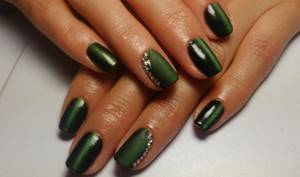
The technique is very simple, you just need to hold a magnet so that a beautiful shining strip appears. This option looks stylish and voluminous, suitable for special occasions.
Matte design
Matte coating appeared quite recently, but has already become a popular fashion trend. Applying it requires patience, time and accuracy. If you make even one inaccurate movement, then everything will have to be redone. Velvet manicure is a good alternative to boring glossy varnish. It looks elegant and attracts the attention of others. If desired, it can be additionally decorated with decorative elements.
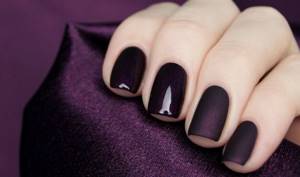
Matte manicure is a practical and versatile option. It is suitable for both parties and workdays.
Ombre
This technique was borrowed from the field of hairdressing. It involves a smooth transition from one color to another. Some masters use not two, but even three or more shades. This is more painstaking work that requires professionalism, but the result will exceed all expectations.
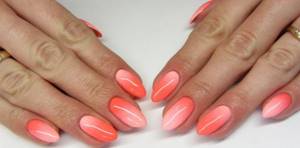
Execution algorithm:
- applying varnish to a damp sponge;
- using a base coat to smooth the nail surface;
- applying colorless varnish to a gradient that has not yet dried;
- updating the palette of varnishes on a sponge for each nail.
With an image
New technologies in nail service are not limited by anything. You can apply any designs and prints to the nail surface: hieroglyphs, letters, flowers, images of animals, geometric motifs, intricate lines.
A design made on one nail, for example, perfectly diversifies the classic French manicure.
Liquid stones
Russian nail art technologist Ekaterina Miroshnichenko has developed a technique for embodying precious stones on nails using colored gels. These can be rubies, emeralds, sapphires and other minerals. A prerequisite for such a manicure is the presence of long and artificial nails.
Technique:
- Giving the nail plates the desired shape.
- Degreasing.
- Creating a contour with art gel.
- Forming a mineral support using colored polymer. It fixes the stone and makes it more iridescent.
- Drying the substrate under a UV lamp.
- Application of a polymer made from stained glass gel into the core. Polymerize it under a lamp for three minutes.
- Applying a clear sculpting gel to add volume to the entire design.
- Applying top coat.
A large number of innovations in the nail industry allows artists to find an approach to any client. Everyone will be able to choose the best coating option for themselves and choose a design to their taste.


